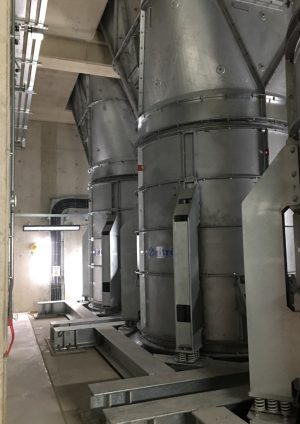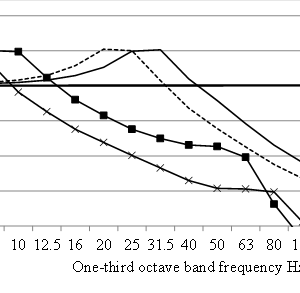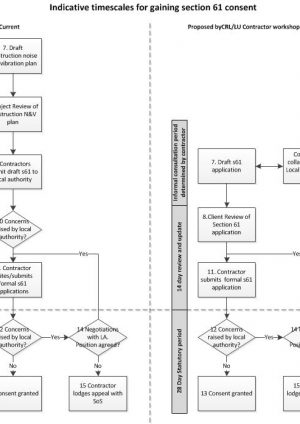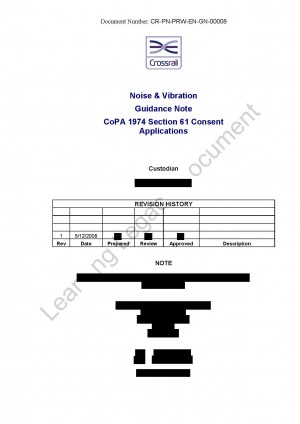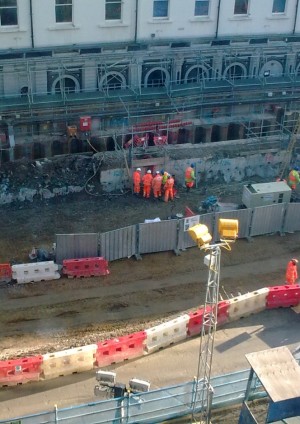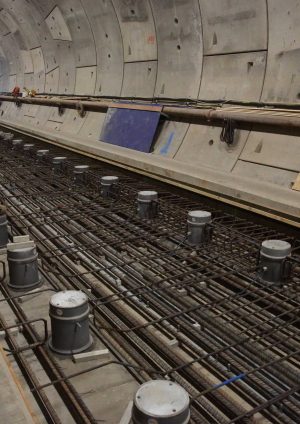 Crossrail delivers new stations and railway infrastructure into urban and suburban communities across London and into the south-east. The control of noise and vibration during construction and the future operation of the railway has been one of the key challenges faced while delivering the programme. The learning legacy aims to share the good practice and lessons learned in the process of addressing them.
Crossrail delivers new stations and railway infrastructure into urban and suburban communities across London and into the south-east. The control of noise and vibration during construction and the future operation of the railway has been one of the key challenges faced while delivering the programme. The learning legacy aims to share the good practice and lessons learned in the process of addressing them.
The construction of Crossrail has required major construction sites in close proximity to residential as well as commercial properties, often with works taking place during the evening, night and weekend. Over 90% of the complaints received throughout the construction of Crossrail to date have been attributed to noise and vibration.
A number of requirements are in place to help minimise the impact on local communities. Contractors are responsible for obtaining consents under Section 61 of the Control of Pollution Act 1974 and for subsequently ensuring that they adhere to and comply with all the requirements of any consent so obtained. A guidance note on applying for section 61 consents for Crossrail construction works was developed with the Local Authorities at the beginning of the project and is provided here. A section 61 lessons learned paper has also been included as part of the learning legacy to provide some learning on this process.
The environmental performance of Crossrail is reliant on the combined performance of the Tier 1 contractors and this is monitored through a Performance Assurance Framework. As part of this process, Crossrail created a bespoke matrix for defining noise management that reflected industry best practice and beyond and worked with its contractors to develop construction related noise and vibration improvement plans. A learning legacy paper, published in March 2017, sets out the approach to promoting improved noise management with case studies from contractors.
The construction of Crossrail has involved major construction works taking place in close proximity to listed buildings, for example at Paddington where the construction site was immediately adjacent to the Grade I listed Paddington Station and at Farringdon, adjacent to the Grade II* listed Smithfield market. Very little information is currently published relating to vibration limits for listed buildings, so this Vibration case study details the precautionary approach that Crossrail and its contractors used to allow construction works to progress at Paddington, whilst ensuring that the Grade I listed building was protected from vibration induced damage.
Crossrail’s 21km of new tunnels have been constructed by eight tunnel boring machines (TBMs). A case study published in September 2016 provides details of the work that was done to minimise noise and vibration impacts from this construction and the results provide a positive legacy that Crossrail leaves for future major tunnelling projects.
A further noise & vibration learning legacy document on groundborne noise and the design of the permanent railway trackform has also been published.
| Summary |
Publication date |
Document Type |
Topic area: Noise and Vibration This paper explains the measures that have been put in place to control the effects of noise from the operation of fixed installations designed and installed as part of Crossrail, with particular focus on the management processes adopted the deliver the associated Assurances.
The term fixed installations encompasses a ...
|
24/08/2018 |
Technical Paper |
Topic area: Noise and Vibration Without mitigation groundborne noise and vibration generated by operational trains has the potential to disturb occupants of existing buildings above the tunnels. As a result, operational groundborne noise and vibration have been an important consideration throughout the planning, design and construction phases of Cros...
|
09/07/2018 |
Technical Paper |
Topic area: Noise and Vibration The Noise and Vibration Guidance Note CoPA 1974 Section 61 Consent Applications and the Model Conditions were developed in consultation with the local authorities and were based upon similar arrangements made between local authorities and other major projects such as CTRL (HS1) and the Thameslink programme.
A lessons l...
|
13/03/2018 |
Good Practice Document |
Topic area: Noise and Vibration Noise was one of the main impacts and challenges during the construction of the Crossrail project. It was recognised that for Crossrail’s Tier 1 contractors to achieve the necessary levels of performance in noise management, focus could not solely be on controlling or minimising noise levels. Factors such as communit...
|
14/03/2017 |
Case Study |
Topic area: Noise and Vibration This case study presents a summary of the work that was undertaken to control ground-borne noise and vibration from the temporary construction railway that was used to deliver tunnel segments and other materials to the tunnel boring machines.
It describes the requirements to control noise and vibration and meet specifi...
|
18/10/2016 |
Case Study |
Topic area: Noise and Vibration This paper sets out the guidance that the nominated undertaker was to adopt when applying for section 61 consents for Crossrail construction works, and also sets out the level of information to be provided in support of section 61 applications. The guidance notes Included templates for section 61 applications, dispensa...
|
26/02/2016 |
Good Practice Document |
Topic area: Noise and Vibration Listed buildings account for 2% of the building stock in England and of those listed buildings, only 2.5% are Grade I listed. Paddington Station, which includes MacMillan House, is Grade I listed because of its historical and architectural importance during the birth and early development of rail transportation in Brit...
|
26/02/2016 |
Case Study |
Topic area: Civil Engineering Crossrail is delivering the Elizabeth line which is due to open in central London from 2018. The new railway includes 42km of tunnels underneath the city.
In sensitive sections of the tunnel network, noise and vibration impacts from the operating railway had to be minimised. The solution was a high density floating tra...
|
26/09/2017 |
Video |
Topic area: Environment Webinars This is the tenth and final webinar in a series of Crossrail Learning Legacy webinars focused on the Environment Theme. It describes how Crossrail has worked in collaboration with its contractors to drive improved performance for noise management.
Noise was one of the main impacts and challenges during the construction...
|
20/07/2017 |
Video |
Topic area: Environment Webinars This is the second in a series of Crossrail Learning Legacy webinars focused on the Environment Theme, hosted by our partners at CIRIA and IEMA. It describes how Crossrail has worked in collaboration to mitigate and manage noise and vibration in a major infrastructure project.
Crossrail delivers new stations and railwa...
|
27/10/2016 |
Video |
 Crossrail delivers new stations and railway infrastructure into urban and suburban communities across London and into the south-east. The control of noise and vibration during construction and the future operation of the railway has been one of the key challenges faced while delivering the programme. The learning legacy aims to share the good practice and lessons learned in the process of addressing them.
Crossrail delivers new stations and railway infrastructure into urban and suburban communities across London and into the south-east. The control of noise and vibration during construction and the future operation of the railway has been one of the key challenges faced while delivering the programme. The learning legacy aims to share the good practice and lessons learned in the process of addressing them.